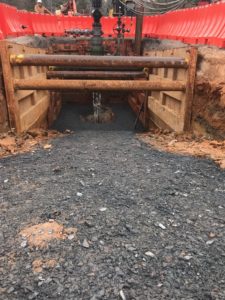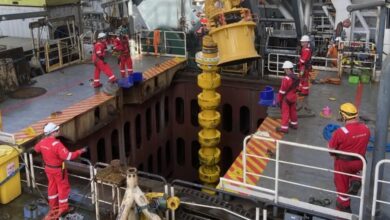Intervention equipment, planning can mitigate complexities that come with multiwell pad spacing
With high-density well spacing, additional considerations are needed around equipment placement and how one well affects other wells on the same pad
By Joe Coleman and Cliff Meade, Wild Well Control
An intervention operation on one well that goes poorly can affect adjacent wells and cause an even greater problem. Well spacing on multiwell pads becomes an issue that concerns equipment placement footprints. Hot Tap, Valve Drilling and Freeze services can be used for gaining well access and placing temporary mechanical barriers when circumstances do not allow for conventional intervention methods.
Freeze Operations

Freeze operations can be used in compact spaces and are beneficial for use on multiwell pads. Freeze services have been used for many years to place a temporary ice plug barrier in tubulars (tubing, drill pipe, casing) when the temporary plug is the only viable option to maintain pressure control. This allows remedial repairs to be made to surface equipment or tubulars. The cryogenic freeze service delivers an expedient, low-cost alternative to conventional well kill operations. Using liquid N2, or CO2, in combination with integral temperature monitors, an effective freeze can be executed safely and efficiently. The freeze process is monitored, and the temperature is precisely maintained to ensure it is kept within recommended guidelines. Through the use of N2, or CO2, the freeze can be put into effect and held indefinitely to isolate inoperable tree components. Once the freeze is established, a positive and/or negative pressure test can be completed to confirm that the temporary barrier is in place and allow repair operations to be conducted. Within certain parameters, cryogenic freezes can be set across multiple strings of casing, which results in an effective temporary barrier in the innermost tubular.
Case Study: Freeze as a Temporary Mechanical Barrier

Following a blowout, the BOP was the only barrier the client had after losing control of the well, and a secondary barrier was required. Wild Well Control was able to provide a secondary barrier with an ice plug as a temporary mechanical barrier. Using freeze services, the client was able to secure the well after dropping the drill pipe.
However, during the event, the BOP was compromised, and the client needed to remove the circulating head to install wireline. The pump-in connection was leaking, and an initial freeze to remove and replace that valve was completed successfully.
Once the pump-in line had established integrity, a lube and bleed of the stack was performed to ensure there was a freezable medium in the stack. Once the ice plug was in place, the temporary barrier was successfully tested to 5,000 psi three times to ensure that all new equipment and connections were adequate before thawing. As a temporary mechanical barrier, the ice plug allowed the client to remove the rotating head and install a fully opening valve for wireline.
Case Study: Gate Valve Drilling for BackPressure Valves
The client had three dual completion wells that had been shut in for a significant period of time, with backpressure valves installed in the tree profile. The client wanted to put the field back on production, thus requiring the removal of the backpressure valves. Over time, the backpressure valves had become stuck in place or had been set incorrectly when they were installed originally. With the backpressure valves in place, there was no vertical access to the well. The client had attempted multiple methods to conventionally remove the stuck valves without success. Wild Well designed and implemented a wash-over tool to cut and remove these damaged valves. A special mill was utilized on the Gate Valve Milling Unit to burn over, capture and recover the backpressure valve. This action allowed the client to access the wellbore to conduct workover operations and to bring the well back on production.
Case Study: Freeze for an Inoperable Gate Valve
The client had a well with an inoperable gate valve that was not fully open. Wild Well recommended using the Gate Valve Milling Unit to fully open the well for wireline access and then to set a plug and replace the tree. The tree valve was milled successfully. However, after gaining access, the tree was fouled by a wireline plug during setting operations. The plug set during the wireline operation failed, and the plug was forced up the hole with well pressure and became lodged across the tree valve; this made further wireline access impossible. The well could not be killed conventionally. Wild Well then recommended using a freeze to set a barrier so that the tree with the stuck wireline plug could be removed. A freeze was determined to be the best method to establish a barrier in the well. For this specific well, the plug needed to be placed under the wellhead, which required excavation work to gain access to the wellhead.
There are multiple excavation options, all of which are site-specific and potentially dangerous if constructed haphazardly. Based on the amount of available space for excavation, one method is to create a large enough excavation so that the slopes of the walls are tailored to the soil that is present. A design criteria is created for the wall slopes to ensure that the walls will resist cave-in.
If the excavation is restricted by other wells on the same pad, then mechanical shoring is often required. Shoring is the process of installing a support system to prevent soil movement and is used when the sloping method is not feasible. This means it is much more difficult to perform a quick excavation in order to tackle a problem.

With larger spacing, where it is possible to perform an open excavation, much of the extra equipment is not required. Shoring requires working in a confined space at a much more technically challenging level. A larger range of hazards are present if shoring is required to secure the area around the well. Further, the items utilized to fix hazards can create potential new issues.
During excavation for this client’s well, it was observed that the drive pipe was noticeably deformed. It was not suitable for freeze operations and would have to be removed. If the grade of pipe is unknown or when drive pipe is deemed unsuitable, then the pipe must be removed prior to freezing operations. A temporary jack can be used to support the weight of the wellhead.
For this well, the drive pipe held a significant amount of the wellhead hangover weight. It could not be removed without transferring that weight to a jack system. Wild Well utilized a third-party jack system and cold-cutting equipment to remove the drive pipe safely. A freeze was performed successfully to remove the tree and set the BOP for workover operations. The plug was tested to 10,000 psi for 15 minutes, followed by a negative test.
Depth of Experience and Pre-planning Considerations
Wild Well brings a diversity of experience to encourage a multidimensional and alternative approach to problem solving. Team members in the field and at the office work together to develop strategies and answers to solve complex well issues. Each well is reviewed on a case-by-case basis, and a collaborative effort is applied to next-step planning for well intervention and multiwell pads.
Major well control events are seldom considered when defining well spacing and equipment layout requirements for multiwell pad designs. Sized for overall support for drilling, completion remediation and production activities, advantages for multiwell pads are a compromise between cost, minimized environmental footprint and overall operational requirements. However, these advantages do not factor in the increased risk from a blowout and intervention perspective. Considerations to be made when designing multiwell pads include close proximity spacing and the potential for dropped objects and collision. Pre-planning during the design phase for multiwell pads can address these potential issues and help minimize the effects of a blowout.
Drilling and completions operations can grow increasingly complex as space becomes more restricted between wells. During intervention operations, the potential for dropped object hazards, collision and damage is more likely to occur due to the compact workspace in and around well sites. There is a higher exposure to potential risk when conducting simultaneous operations on a pad with densely spaced wells. This risk must be weighed against potential cost savings. Much consideration and discussion goes into solving well access problems, and the best method to reduce potential consequences from a blowout is through pre-planning. Contingency planning can help clients address potential concerns before, during and after field operations.
Working in space-restricted areas creates a larger project with additional risks on that wellsite. As part of pre-planning, Wild Well can address project concerns like fall radius and the parameters for working safely within the zone. Necessary protection items needed to safeguard the wells can be addressed through blast shield options. With common cellars, design considerations may include the installation and use of blast walls. Blast walls can be installed between individual wellheads as an integral component to offset the effects of heat radiation. Concrete blast walls may fail when exposed to high radiant heat. Steel-reinforced paneling can be used to protect adjacent wells from heat. The walls can also be used to reduce collateral damage from dropped objects and collision. Key pre-planning services can properly identify optimal positioning for the excavation and intervention equipment.
Conclusion
Well spacing on multiwell pads increases pre-planning considerations that need to be accounted for, where it concerns equipment placement footprints. It must be taken into consideration how work on one well affects other wells on the pad. Space restrictions for well operations can be overcome, especially for multiwell pad designs, with freeze services and specialized intervention equipment. Hot Tap, Valve Drilling and Freeze specialized intervention equipment allow for well access and temporary isolation and to check for pressure in the wellbore in compact areas, while offering special care and attention to dropped objects, fall and collision hazards. DC




